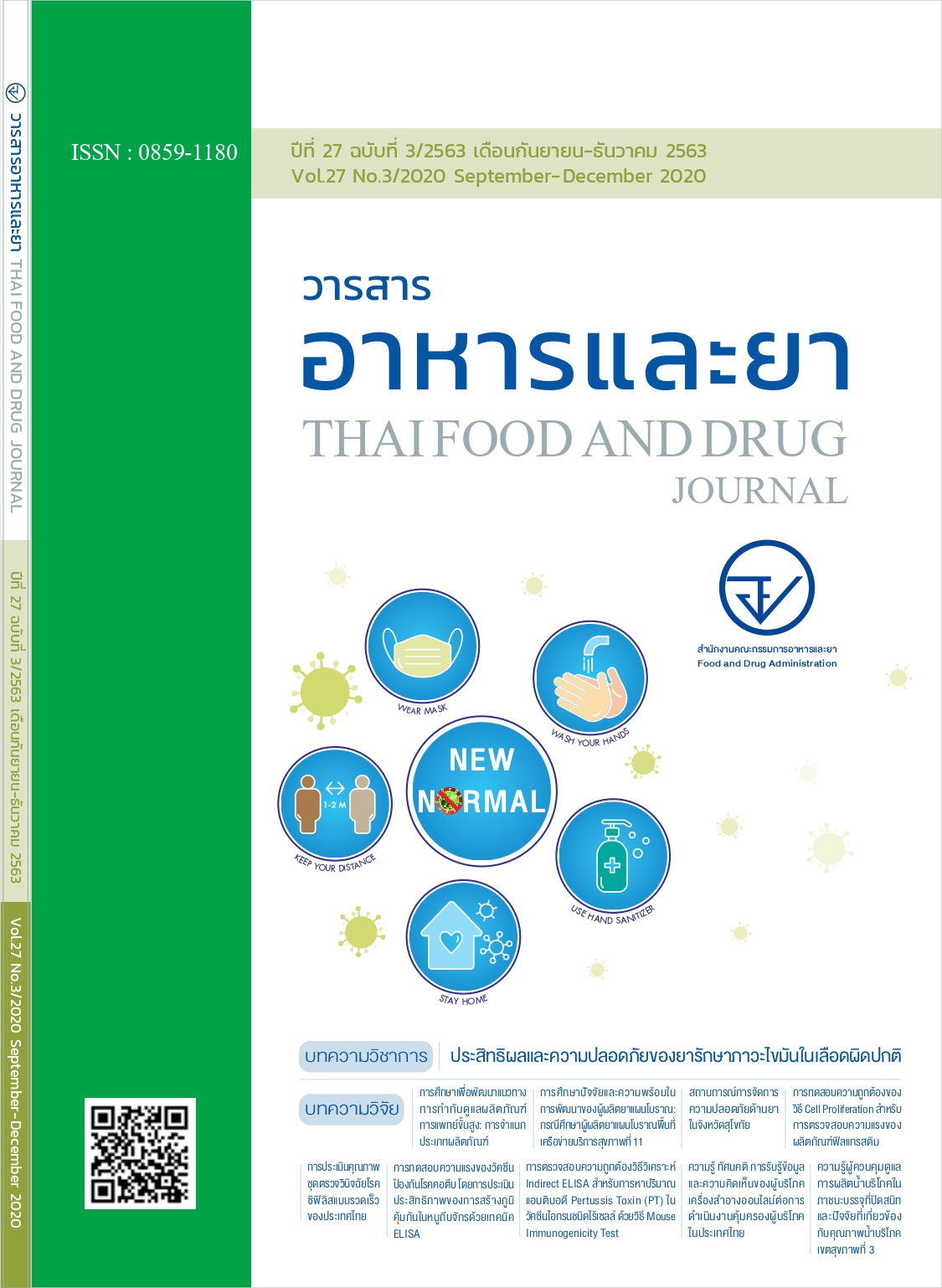การศึกษาเพื่อพัฒนาแนวทางการกำกับดูแลผลิตภัณฑ์การแพทย์ขั้นสูง: การจำแนกประเภทผลิตภัณฑ์
Main Article Content
บทคัดย่อ
การวิจัยและพัฒนาผลิตภัณฑ์การแพทย์ขั้นสูง อาทิ ผลิตภัณฑ์เซลล์ต้นกำเนิด ผลิตภัณฑ์เซลล์บำบัด ผลิตภัณฑ์ยีนบำบัด ฯลฯ ในปัจจุบันมีแนวโน้มที่สูงขึ้นจากความสนใจของหน่วยวิจัยจากทั้งภาครัฐและเอกชน ด้วยคุณสมบัติของผลิตภัณฑ์ที่มีความเฉพาะเจาะจงต่อตัวผู้ป่วยและโรคที่รักษา แต่ด้วยความซับซ้อนของกระบวน การผลิตและกลไกการออกฤทธิ์ของผลิตภัณฑ์จึงสามารถจัดผลิตภัณฑ์ส่วนใหญ่เป็นผลิตภัณฑ์ที่มีความเสี่ยงสูงหลายประเทศจึงต้องกำหนดหลักเกณฑ์หรือแนวทางที่เหมาะสมกับการกำกับดูแลผลิตภัณฑ์เหล่านี้ อนึ่งการจัด ประเภทผลิตภัณฑ์ถือเป็นองค์ประกอบหนึ่งที่สำคัญสำหรับพัฒนาหลักเกณฑ์การกำกับดูแลผลิตภัณฑ์อย่างถูกต้อง และเหมาะสม การศึกษานี้ได้ดำเนินการศึกษาแนวทางการจัดประเภทผลิตภัณฑ์การแพทย์ขั้นสูงของประเทศต้นแบบ ได้แก่ ประเทศสหรัฐอเมริกา กลุ่มสหภาพยุโรป และประเทศญี่ปุ่น จากวรรณกรรม หลักเกณฑ์ หรือข้อกฎหมาย ที่เกี่ยวข้องของประเทศนั้น ๆ และวิเคราะห์แนวทางการจัดประเภทผลิตภัณฑ์การแพทย์ขั้นสูงสำหรับประเทศไทย
ซึ่งจากการศึกษาพบว่าประเทศดังกล่าวมีการจัดประเภทผลิตภัณฑ์การแพทย์ขั้นสูงโดยพิจารณาจากความเสี่ยง ของผลิตภัณฑ์ที่ได้มาด้วยกรรมวิธีหรือกระบวนการที่นำมาใช้ในการผลิตผลิตภัณฑ์ รวมไปถึงความเสี่ยงจากการใช้ ผลิตภัณฑ์นั้น โดยหน่วยงานกำกับดูแลผลิตภัณฑ์ของประเทศที่ศึกษาจะทำหน้าที่กำกับดูแลผลิตภัณฑ์ที่จัดเป็น ผลิตภัณฑ์การแพทย์ขั้นสูงที่มีความเสี่ยงสูงเป็นหลัก ด้วยเหตุนี้ สำนักงานคณะกรรมการอาหารและยา จึงควร พิจารณาจัดทำหลักเกณฑ์ที่สามารถระบุได้ว่ากรรมวิธี กระบวนการ หรือการใช้ผลิตภัณฑ์อย่างไรที่หน่วยวิจัยภาครัฐ และภาคเอกชน ตลอดจนแพทย์สามารถดำเนินการได้ทันทีหรือดำเนินการได้ก็ต่อเมื่อได้รับอนุญาตจากสำนักงานฯ เท่านั้น เพื่อให้การคุ้มครองผู้บริโภคเป็นไปอย่างมีประสิทธิภาพ นอกจากนี้ในการจำแนกผลิตภัณฑ์การแพทย์ขั้นสูง
ยังควรพิจารณาถึงการจำแนกประเภทของผลิตภัณฑ์ที่อยู่ภายใต้ผลิตภัณฑ์การแพทย์ขั้นสูงด้วย โดยการศึกษานี้ เสนอให้จำแนกผลิตภัณฑ์ออกเป็นประเภทต่าง ๆ ได้แก่ ผลิตภัณฑ์เซลล์บำบัด ผลิตภัณฑ์ยีนบำบัด ผลิตภัณฑ์ วิศวกรรมเนื้อเยื่อ และผลิตภัณฑ์การแพทย์ขั้นสูงผสม เพื่อเป็นการเตรียมความพร้อมสำหรับการกำกับดูแลผลิตภัณฑ์การแพทย์ขั้นสูงในแต่ละประเภทต่อไป
Article Details
เอกสารอ้างอิง
2. Hourd P, Chandra A, Medcalf N, et al.Regulatory challenges for the manufacture and scale-out of autologous cell therapies. 2014 Mar 31. In: Girard L, editors. StemBook
[Internet]. Cambridge (MA): Harvard Stem Cell Institute; 2008.
3. Hurley P, Jurmeister S, Parsley K. Advanced therapy medicinal products - an evolving regulatory landscape. Regulatory focus 2017; 1-7.
4. Halioua-Haubold CL, Peyer JG, Smith JA,et al. Regulatory considerations for gene therapy products in the US, EU, and Japan. The Yale Journal of Biology and Medicine
2017, 90(4): 683–693.
5. O’Brien D. The importance of product classification [PowerPoint slides]. Irish Medicines Board; 2012.
6. US Food and Drug Administration. Guidance for industry: Regulation of human cells, tissues, and cellular and tissue-based products (HCT/Ps), small entity compliance
guide, 2007.
7. Gadriock P. HCT/P regulation – 351 vs 361 products [PowerPoint slides]. Arent Fox; 2017.
8. Oh SS. FDA’s perspectives on cellular and gene therapy regulation [PowerPoint slides]. International Regulatory Forum of Human Cell Therapy and Gene Therapy Products; 2016.
9. Berseney A. (2014). FDA clarifies minimal manipulation of cell/tissue products. Stem Cell Assays [Internet]. 2014.
10. US Food and Drug Administration. Guidance for industry and food and drug administration staff: Regulatory Considerations for human cells, tissues, and cellular and tissue-based products: Minimal manipulation and homologous use, 2017.
11. Regulation (EC) No 1394/2007 of the European Parliament and of the Council of 13 November 2007 on advanced therapy medicinal products and amending Directive
2001/83/EC and Regulation (EC) No 726/ 2004 (L. 324/121-137).
12. Bravery CA. EU vs US Regulation impact on global development [PowerPoint slides].
13. Ministry of Health, Labour and Welfare. Institutional framework for promoting the future implementation of regenerative medicine [PowerPoint slides].
14. Maruyama Y. Regulation of regenerative medicine in Japan [PowerPoint slides].Health Products Regulatory Conference; 2017.
15. Tobita M, Konomi K, Torashima Y, et al. Japan’s challenges of translational regenerative medicine: Act on the safety of regenerative medicine. Regenerative
Therapy 2016;4:78-81.
16. CJ Partners. Regenerative medicine in Japan [PowerPoint slides]. CJ Partners; 2016.
17. ประกาศสำนักงานคณะกรรมการอาหารและยา เรื่อง การควบคุม กำกับ ดูแลยาที่เป็นผลิตภัณฑ์การแพทย์ขั้นสูง (ลงวันที่ 7 มีนาคม 2561).


